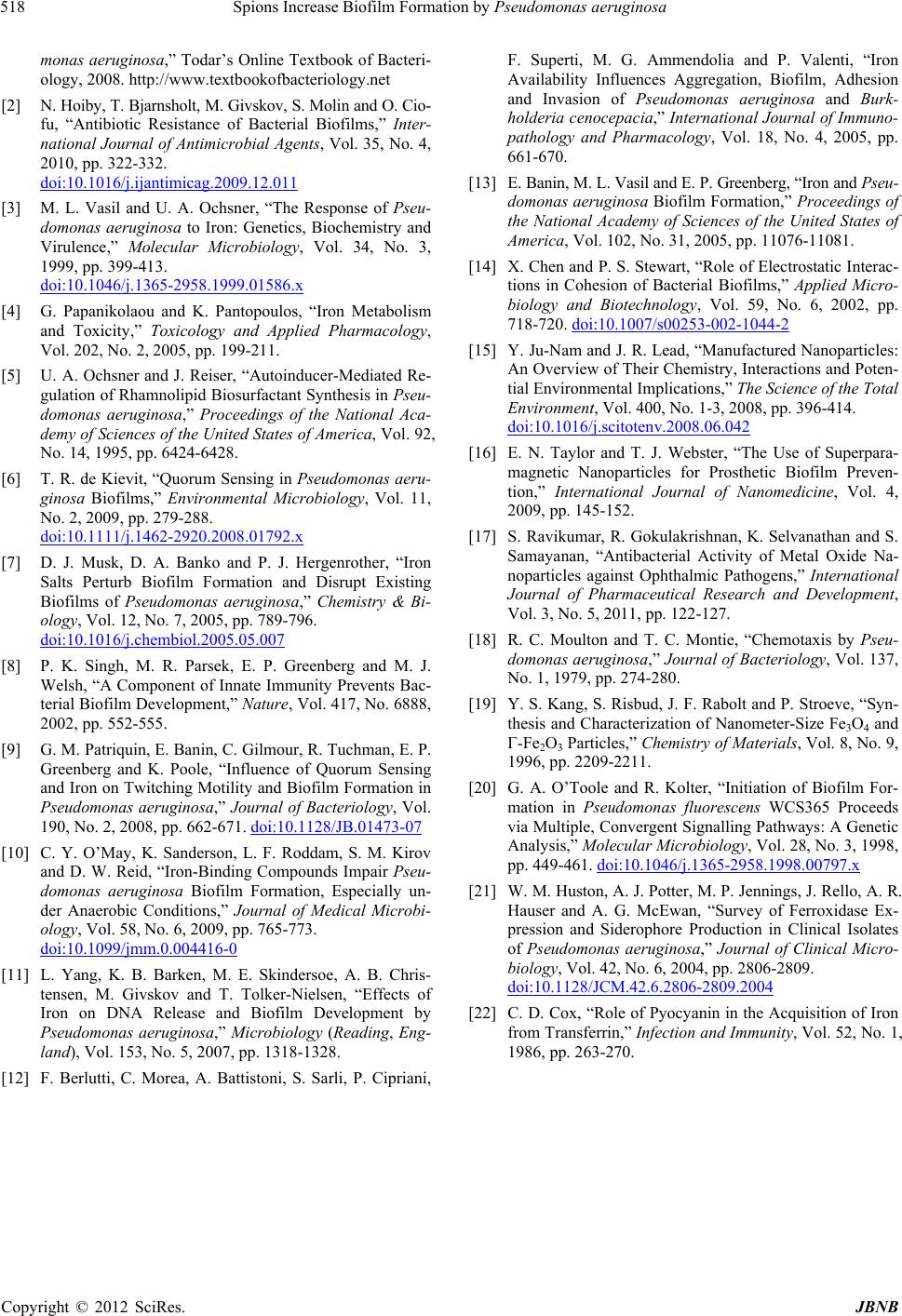
Spions Increase Biofilm Formation by Pseudomonas aeruginosa
Copyright © 2012 SciRes. JBNB
518
monas aeruginosa,” Todar’s Online Textbook of Bacteri-
ology, 2008. http://www.textbookofbacteriology.net
[2] N. Hoiby, T. Bjarnsholt, M. Givskov, S. Molin and O. Cio-
fu, “Antibiotic Resistance of Bacterial Biofilms,” Inter-
national Journal of Antimicrobial Agents, Vol. 35, No. 4,
2010, pp. 322-332.
doi:10.1016/j.ijantimicag.2009.12.011
[3] M. L. Vasil and U. A. Ochsner, “The Response of Pseu-
domonas aeruginosa to Iron: Genetics, Biochemistry and
Virulence,” Molecular Microbiology, Vol. 34, No. 3,
1999, pp. 399-413.
doi:10.1046/j.1365-2958.1999.01586.x
[4] G. Papanikolaou and K. Pantopoulos, “Iron Metabolism
and Toxicity,” Toxicology and Applied Pharmacology,
Vol. 202, No. 2, 2005, pp. 199-211.
[5] U. A. Ochsner and J. Reiser, “Autoinducer-Mediated Re-
gulation of Rhamnolipid Biosurfactant Synthesis in Pseu-
domonas aeruginosa,” Proceedings of the National Aca-
demy of Sciences of the United States of America, Vol. 92,
No. 14, 1995, pp. 6424-6428.
[6] T. R. de Kievit, “Quorum Sensing in Pseudomonas aeru-
ginosa Biofilms,” Environmental Microbiology, Vol. 11,
No. 2, 2009, pp. 279-288.
doi:10.1111/j.1462-2920.2008.01792.x
[7] D. J. Musk, D. A. Banko and P. J. Hergenrother, “Iron
Salts Perturb Biofilm Formation and Disrupt Existing
Biofilms of Pseudomonas aeruginosa,” Chemistry & Bi-
ology, Vol. 12, No. 7, 2005, pp. 789-796.
doi:10.1016/j.chembiol.2005.05.007
[8] P. K. Singh, M. R. Parsek, E. P. Greenberg and M. J.
Welsh, “A Component of Innate Immunity Prevents Bac-
terial Biofilm Development,” Nature, Vol. 417, No. 6888,
2002, pp. 552-555.
[9] G. M. Patriquin, E. Banin, C. Gilmour, R. Tuchman, E. P.
Greenberg and K. Poole, “Influence of Quorum Sensing
and Iron on Twitching Motility and Biofilm Formation in
Pseudomonas aeruginosa,” Journal of Bacteriology, Vol.
190, No. 2, 2008, pp. 662-671. doi:10.1128/JB.01473-07
[10] C. Y. O’May, K. Sanderson, L. F. Roddam, S. M. Kirov
and D. W. Reid, “Iron-Binding Compounds Impair Pseu-
domonas aeruginosa Biofilm Formation, Especially un-
der Anaerobic Conditions,” Journal of Medical Microbi-
ology, Vol. 58, No. 6, 2009, pp. 765-773.
doi:10.1099/jmm.0.004416-0
[11] L. Yang, K. B. Barken, M. E. Skindersoe, A. B. Chris-
tensen, M. Givskov and T. Tolker-Nielsen, “Effects of
Iron on DNA Release and Biofilm Development by
Pseudomonas aeruginosa,” Microbiology (Reading, Eng-
land), Vol. 153, No. 5, 2007, pp. 1318-1328.
[12] F. Berlutti, C. Morea, A. Battistoni, S. Sarli, P. Cipriani,
F. Superti, M. G. Ammendolia and P. Valenti, “Iron
Availability Influences Aggregation, Biofilm, Adhesion
and Invasion of Pseudomonas aeruginosa and Burk-
holderia cenocepacia,” International Journal of Immuno-
pathology and Pharmacology, Vol. 18, No. 4, 2005, pp.
661-670.
[13] E. Banin, M. L. Vasil and E. P. Greenberg, “Iron and Pseu-
domonas aeruginosa Biofilm Formation,” Proceedings of
the National Academy of Sciences of the United States of
America, Vol. 102, No. 31, 2005, pp. 11076-11081.
[14] X. Chen and P. S. Stewart, “Role of Electrostatic Interac-
tions in Cohesion of Bacterial Biofilms,” Applied Micro-
biology and Biotechnology, Vol. 59, No. 6, 2002, pp.
718-720. doi:10.1007/s00253-002-1044-2
[15] Y. Ju-Nam and J. R. Lead, “Manufactured Nanoparticles:
An Overview of Their Chemistry, Interactions and Poten-
tial Environmental Implications,” The Science of the Total
Environment, Vol. 400, No. 1-3, 2008, pp. 396-414.
doi:10.1016/j.scitotenv.2008.06.042
[16] E. N. Taylor and T. J. Webster, “The Use of Superpara-
magnetic Nanoparticles for Prosthetic Biofilm Preven-
tion,” International Journal of Nanomedicine, Vol. 4,
2009, pp. 145-152.
[17] S. Ravikumar, R. Gokulakrishnan, K. Selvanathan and S.
Samayanan, “Antibacterial Activity of Metal Oxide Na-
noparticles against Ophthalmic Pathogens,” International
Journal of Pharmaceutical Research and Development,
Vol. 3, No. 5, 2011, pp. 122-127.
[18] R. C. Moulton and T. C. Montie, “Chemotaxis by Pseu-
domonas aeruginosa,” Journal of Bacteriology, Vol. 137,
No. 1, 1979, pp. 274-280.
[19] Y. S. Kang, S. Risbud, J. F. Rabolt and P. Stroeve, “Syn-
thesis and Characterization of Nanometer-Size Fe3O4 and
Γ-Fe2O3 Particles,” Chemistry of Materials, Vol. 8, No. 9,
1996, pp. 2209-2211.
[20] G. A. O’Toole and R. Kolter, “Initiation of Biofilm For-
mation in Pseudomonas fluorescens WCS365 Proceeds
via Multiple, Convergent Signalling Pathways: A Genetic
Analysis,” Molecular Microbiology, Vol. 28, No. 3, 1998,
pp. 449-461. doi:10.1046/j.1365-2958.1998.00797.x
[21] W. M. Huston, A. J. Potter, M. P. Jennings, J. Rello, A. R.
Hauser and A. G. McEwan, “Survey of Ferroxidase Ex-
pression and Siderophore Production in Clinical Isolates
of Pseudomonas aeruginosa,” Journal of Clinical Micro-
biology, Vol. 42, No. 6, 2004, pp. 2806-2809.
doi:10.1128/JCM.42.6.2806-2809.2004
[22] C. D. Cox, “Role of Pyocyanin in the Acquisition of Iron
from Transferrin,” Infection and Immunity, Vol. 52, No. 1,
1986, pp. 263-270.